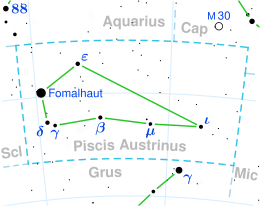Iota Piscis Austrini (ι Piscis Austrini) is a solitary,[7] blue-white hued star in the southern constellation of Piscis Austrinus. It has an apparent visual magnitude of +4.35[2] and is around 500 light years from the Sun. This is an A-type main sequence star with a stellar classification of A0 V.[3] It has a magnitude 11.4 visual companion located at an angular separation of 20 arc seconds along a position angle of 290°, as of 1910.[8]
| Observation data Epoch J2000.0 Equinox J2000.0 (ICRS) | |
|---|---|
| Constellation | Piscis Austrinus |
| Right ascension | 21h 44m 56.809s[1] |
| Declination | −33° 01′ 32.82″[1] |
| Apparent magnitude (V) | +4.35[2] |
| Characteristics | |
| Spectral type | A0 V[3] or A0 III-IV[4] |
| U−B color index | −0.11[2] |
| B−V color index | −0.05[2] |
| Astrometry | |
| Proper motion (μ) | RA: +31.10[1] mas/yr Dec.: −94.56[1] mas/yr |
| Parallax (π) | 15.97 ± 0.17 mas[1] |
| Distance | 204 ± 2 ly (62.6 ± 0.7 pc) |
| Absolute magnitude (MV) | +0.37[4] |
| Details | |
| Luminosity | 87[4] L☉ |
| Temperature | 9,330[5] K |
| Rotational velocity (v sin i) | 50[3] km/s |
| Other designations | |
| Database references | |
| SIMBAD | data |
Iota Piscis Austrini is moving through the Galaxy at a speed of 29.7 km/s relative to the Sun. Its projected Galactic orbit carries it between 18,400 and 24,300 light years from the center of the Galaxy.[9][unreliable source?]
Naming
editIn Chinese, 天錢 (Tiān Qián), meaning Celestial Money, refers to an asterism consisting of refers to an asterism consisting of ι Piscis Austrini 13 Piscis Austrini, θ Piscis Austrini, μ Piscis Austrini and τ Piscis Austrini. Consequently, the Chinese name for ι Piscis Austrini itself is 天錢三 (Tiān Qián sān, English: the Third Star of Celestial Money.)[10]
References
edit- ^ a b c d e van Leeuwen, F. (2007), "Validation of the new Hipparcos reduction", Astronomy and Astrophysics, 474 (2): 653–664, arXiv:0708.1752, Bibcode:2007A&A...474..653V, doi:10.1051/0004-6361:20078357, S2CID 18759600.
- ^ a b c d Drilling, J. S. (December 1971), "UBV photometry of early-type stars in two regions at high galactic latitudes", Astronomical Journal, 76: 1072, Bibcode:1971AJ.....76.1072D, doi:10.1086/111221.
- ^ a b c Levato, O. H. (August 1972), "Rotational Velocities and Spectral Types of Some A-Type Stars", Publications of the Astronomical Society of the Pacific, 84 (500): 584, Bibcode:1972PASP...84..584L, doi:10.1086/129336, S2CID 122833746.
- ^ a b c Anderson, E.; Francis, Ch. (2012), "XHIP: An extended hipparcos compilation", Astronomy Letters, 38 (5): 331, arXiv:1108.4971, Bibcode:2012AstL...38..331A, doi:10.1134/S1063773712050015, S2CID 119257644.
- ^ Brown, A. G. A.; et al. (Gaia collaboration) (August 2018). "Gaia Data Release 2: Summary of the contents and survey properties". Astronomy & Astrophysics. 616. A1. arXiv:1804.09365. Bibcode:2018A&A...616A...1G. doi:10.1051/0004-6361/201833051. Gaia DR2 record for this source at VizieR.
- ^ "iot PsA -- Star", SIMBAD Astronomical Database, Centre de Données astronomiques de Strasbourg, retrieved 2017-05-18.
- ^ Eggleton, P. P.; Tokovinin, A. A. (September 2008), "A catalogue of multiplicity among bright stellar systems", Monthly Notices of the Royal Astronomical Society, 389 (2): 869–879, arXiv:0806.2878, Bibcode:2008MNRAS.389..869E, doi:10.1111/j.1365-2966.2008.13596.x, S2CID 14878976.
- ^ Mason, B. D.; et al. (2014), "The Washington Visual Double Star Catalog", The Astronomical Journal, 122 (6): 3466, Bibcode:2001AJ....122.3466M, doi:10.1086/323920, retrieved 2015-07-22
- ^ Iota Piscis Austrini (HIP 107380)
- ^ (in Chinese) AEEA (Activities of Exhibition and Education in Astronomy) 天文教育資訊網 2006 年 7 月 5 日 Archived 2011-05-21 at the Wayback Machine
